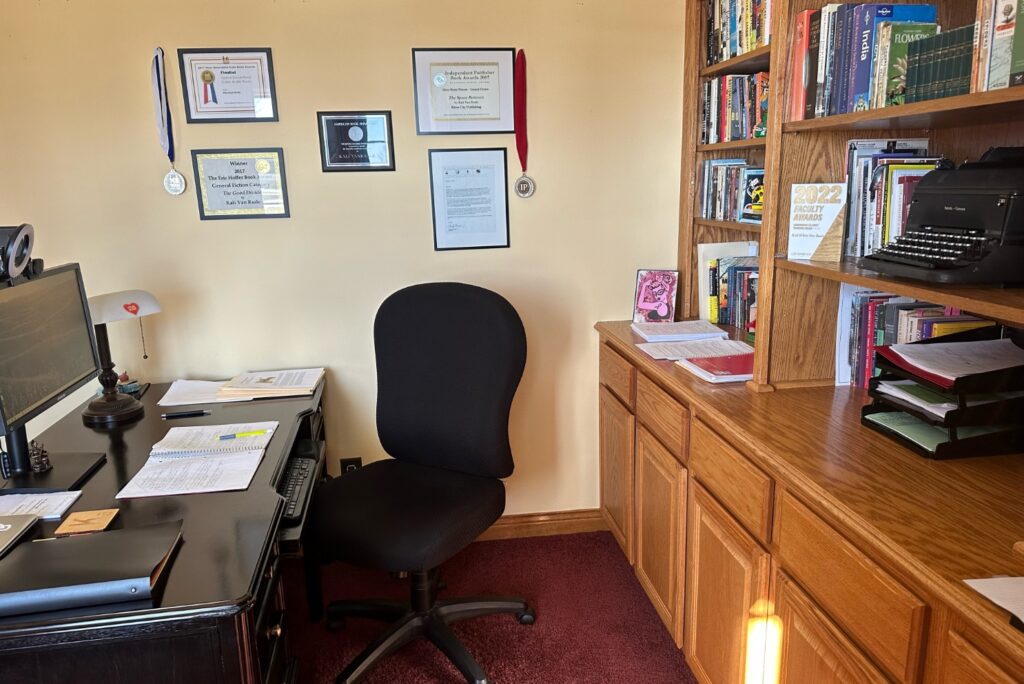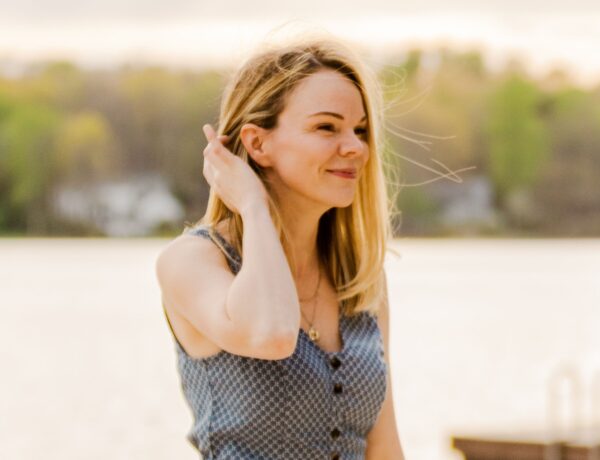Kali White VanBaale is the author of the novels The Monsters We Make, The Good Divide, and The Space Between.
She’s the recipient of an American Book Award, an Independent Publisher’s silver medal for general fiction, the Fred Bonnie Memorial First Novel Award, the Eric Hoffer Book Award for General Fiction, two Iowa Arts Council major artist grants, and the Great River Writer’s Retreat.
She also writes and publishes short stories and essays, is a regular contributor to the A&E Network True Crime blog series, and serves as the managing editor of the micro-essay journal Past Ten.
Looking for inspiration to help you achieve your writing goals? Subscribe to our newsletter for exclusive insights into the routines, habits, and techniques of some of the most celebrated authors in history.
Hi Kali, welcome to Famous Writing Routines, great to have you here with us today! You’ve had a really diverse professional background, from working on a Christmas tree farm to serving as a county case manager. How did those experiences shape your writing and perspective on the world?
Thank you so much for inviting me! Oh, boy, I’ve definitely worked a range of jobs. Waitress, jewelry counter attendant (I can still change a watch band like nobody’s business), gymnastics coach, library clerk, and yes, I was a Christmas tree farm hand one very broke holiday season in college and worked as a county case manager for my first post-grad job.
All my collective work experiences, I think, really shaped my work ethic for the rest of my life. Those early jobs taught me grit and perseverance, which has served me well as a writer. I’m totally unbothered by hard work and take setbacks and rejections to the chin like a professional boxer. I just get right back up and start swinging again.
For your 2020 novel, The Monsters We Make, what inspired you to write about the Des Moines Register paperboy kidnappings in the 1980s?
When Johnny Gosch was abducted in 1982, I was only 7 and lived two hours away, so I wasn’t really aware of that news story when it first happened. But when Eugene Martin went missing in 1984, I was 9 and happened to be on a rare trip to Des Moines with my family and was staying in a hotel just blocks away from where Eugene disappeared.
The morning the news broke, I have a distinct memory of looking at the downtown Des Moines skyline and thinking, someone out there is stealing children, and the realization absolutely shook me. I was a sheltered farm kid up to that point and nothing of the sort had ever occurred to me. The cases haunted me well into adulthood, and eventually a story idea started to take root.
The book explores the theme of secrets and the impact they have on relationships. Can you talk about the process of developing the characters and their motivations?
I started with the character of Crystal first—an inquisitive girl living in the middle of this sensational crime in her neighborhood. Her younger brother Sammy was the next character I started writing, and in the first scene I wrote for him, he started to unexpectedly take over, as characters often do, and I realized he had a terrible secret he was hiding and that the paperboy abduction in his neighborhood inadvertently threatened to expose it.
From that point on, all the other characters grew from Crystal and Sammy, and from Sammy’s efforts to hide his terrible secret, and Crystal unwittingly moving closer and closer to the truth of it.
Your writing has been described as “taut” and “muscular.” How do you approach writing suspenseful scenes?
First, I’m never interested in writing or showing every single graphic detail of violent crimes themselves. I’m always more interested in exploring the emotionality of a suspenseful scene. The tense lead up, the moment of realization, and the emotional fallout. How the characters are different in the aftermath.
And suspenseful scenes are so hard to write! It’s a balancing act at all times—tension, pacing, emotional reactions, concise language—and those scenes take so many revision passes, for me anyway. I find that I have to write those moments, and then revise, revise, revise to ultimately get out of the way and just let the scenes do what they need to do.
In addition to your novels, you also write and publish short stories and essays, and you’re a regular contributor to the A&E Network True Crime blog series. Can you talk a bit about how you approach writing in these different formats, and how you balance your time between them?
Before graduate school I only wrote novels, but my MFA experience really encouraged me to try writing across multiple genres, like short stories, flash fiction, and personal essays, which I love to do between novel projects as something of a palate cleanser.
Then when the pandemic shutdown canceled all my in-person events to promote The Monsters We Make, I quickly learned peripheral marketing to keep reaching true crime readers through other avenues, which led me to writing true crime articles and interviews for A&E. It’s a fun gig and, again, something totally fresh and different I can do between novel drafts. I like to stay challenged, and diversifying my writing helps create a steady flow of projects.
You have an MFA in creative writing from Vermont College of Fine Arts and have received two Iowa Arts Council major artist grants. How did your formal education in writing help you hone your craft, and what do you think is the most important aspect of writing for aspiring writers to focus on?
I think my time in an MFA program most importantly thickened my skin for the tough publishing world. It also taught me how to interact with texts not just on a reader response level, but on a craft level, how to take apart and understand all the inner workings that create the whole.
As for the most important aspect for aspiring writers to focus on, I constantly tell my MFA students two things:
- Learn how to finish a first draft
- Learn how to do serious revisions
Above all else, this is how writing gets done. Figure out what it takes for you to finish a first draft, no matter how crappy it is. So many novels fail not because they’re bad, but because they never get finished. Then embrace and learn how to seriously rewrite and revise. I don’t mean editing—changing words or fixing typos—I mean revising, revisioning, to see something differently.
This is where working writers really start to separate themselves from the pack. They’ve learned how to really dig into their manuscripts to cut, slash, rewrite, rearrange—whatever it takes to make the work stronger.
Discover the daily writing habits of authors like Stephen King, Neil Gaiman, and Gillian Flynn with Famous Writing Routines Vol. 1 and learn how to take your writing to the next level. Grab your copy today!
Can you tell us about your writing routine? What does a typical day look like for you?
Since I’m both a writer and writing professor, I split my days between the two disciplines.
I write in the mornings, usually from about 8am until 12pm. Whether I’m writing first draft pages or deep into rewrites and revisions, I try really hard to protect those four hours. I silence my phone, disconnect from the internet, close my office blinds and door, and basically hunker down to focus.
Then in the afternoons, I open the blinds and the door (and let the dog in to pester me), turn my phone ringer back on, and log into my online MFA creative writing classes and switch to teaching. Because my classes are asynchronous, I have a lot of flexibility in afternoons to work around other “life” things that come up, which is pretty great.
If you could have a conversation with any author throughout history about their writing routine and creative process, who would that person be?
I’m a huge fan of Dennis Lehane and Mystic River and would love to ask him a million questions about that book, about his artistic decisions in point of view, voice, and structure.
I’m also a super fan of Jane Hamilton. I’ve met her a couple of times in person and I’m convinced we could be BFFs.
I’d love to know about the books you’re reading at the moment. What have been some of your favorite recent reads?
I’m currently reading Tell Me an Ending by Jo Harkin and loving it so far, and just finished Now Is Not the Time to Panic by Kevin Wilson, which I adored.

Affiliate disclaimer: Some links on this website are affiliate links. We may earn a small commission if you make a purchase through these links, but only promote products we truly believe in. We disclose affiliate links and give honest reviews.



No Comments